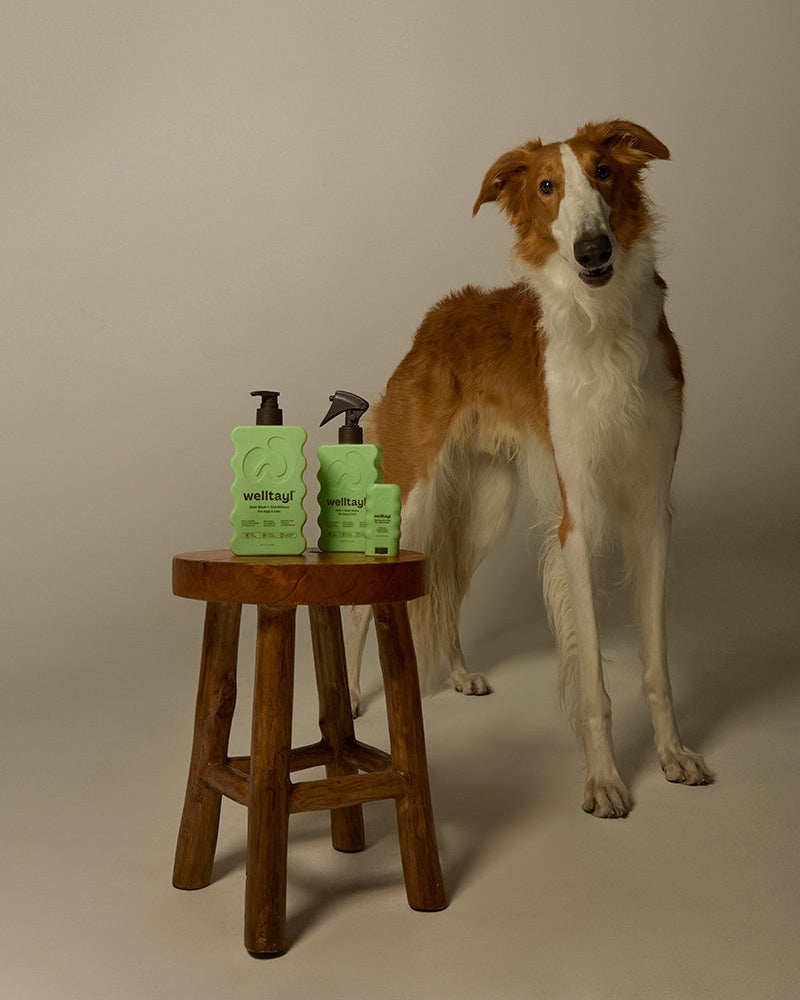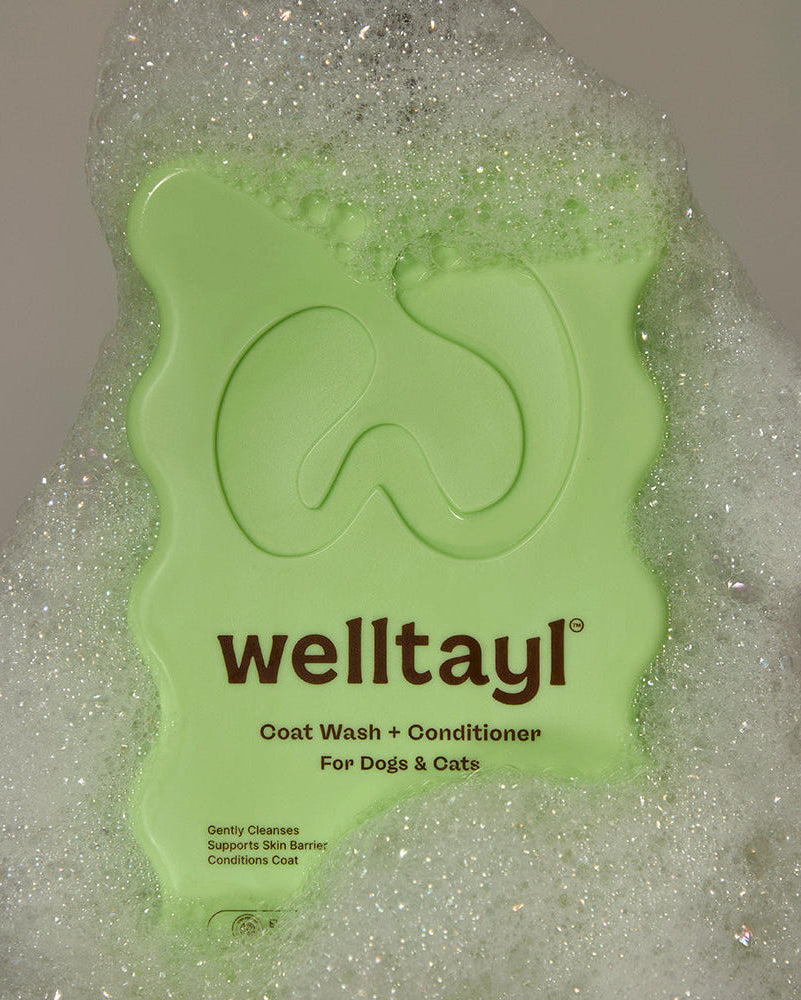Dog skin conditions are actually one of the top reasons pets visit the vet. Knowing what to look out for can make a big difference in catching these issues early.
From pesky fleas that cause itching and redness to allergies that lead to flaky skin and hair loss, your dog's skin problems can vary widely. They might show signs like scratching, having a foul odor, or even developing some oozing sores. It's not just about looking good—it's crucial for their overall health.
Let’s dive into these common skin conditions and how you can help protect your pup’s precious skin.
Table of Contents:
- Key Takeaways
- 6 Common Dog Skin Conditions:
- Signs and Symptoms of Dog Skin Conditions
- How to Diagnose Dog Skin Conditions
- Treatment Options for Dog Skin Conditions
- Prevention of Dog Skin Conditions
- Conclusion
- Frequently Asked Questions
Key Takeaways
- 🐕 Variety of Conditions: Dogs can suffer from various skin conditions, including allergies, fungal infections, parasites, hormonal imbalances, autoimmune diseases, and nutritional disorders. Each condition has specific symptoms and requires different treatment approaches.
- ❤️🩹 Symptoms to Watch For: Common signs of skin conditions in dogs include persistent scratching, red or inflamed skin, hair loss, foul odor, and the development of sores or oozing spots. These symptoms often necessitate a veterinary examination.
- 🦠 Allergies as a Common Cause: Environmental allergens (like pollen and dust), food ingredients, and flea bites are typical triggers of allergic dermatitis in dogs, causing symptoms such as itching, redness, and secondary infections.
- 🧪 Diagnostic Methods: Accurate diagnosis usually involves a combination of veterinary examination, skin scraping tests, allergy testing, and sometimes blood tests to identify underlying causes such as hormonal imbalances.
- 💊 Treatment Approaches: Treatment can include topical applications , oral medications, hypoallergenic diets, and in some cases, immunotherapy for long-term allergy management.
- 🧴 Preventive Measures: Regular grooming, appropriate flea control, and dietary management are crucial in preventing skin conditions. Regular vet check-ups can help catch and treat conditions early.
- 🩺 When to See a Vet: Immediate veterinary consultation is recommended if a dog shows persistent or severe symptoms like excessive scratching, redness, sores, or behavioral changes indicating discomfort.

6 Common Dog Skin Conditions:
1. Allergies
Allergies often cause your dog's skin to become red, itchy, and inflamed. The main culprits are usually environmental triggers like pollen, dust, and mold, but can also include fleas or ingredients in dog food. Symptoms typically manifest as scratching, licking, or biting the skin, leading to hair loss and potentially secondary infections. Treatment generally involves identifying the allergen through elimination diets or allergy testing, followed by managing exposure and, if needed, medication to control symptoms.
2. Fungal Infections
Fungal infections, such as ringworm, are marked by circular, crusty patches on the skin that may grow in size. They're caused by fungi that thrive in moist environments, making dogs with dense fur or those living in humid climates more susceptible. Treatment includes topical antifungal creams or shampoos and sometimes oral medications, alongside thorough decontamination of their environment to prevent recurrence.
3. Parasites
Parasites like fleas, ticks, and mange mites cause skin disorders in dogs, leading to intense itching and irritation. Flea infestations result in red, pimple-like bumps primarily around the neck and back.You may even see fleas crawling on your pet. Mange causes severe itching and fur loss, typically around the ears and face. Mange mites cannot be seen with the naked eye. Effective treatment involves using regular parasite control measures.
4. Hormonal Imbalances
Hormonal imbalances can lead to skin conditions in dogs too. Hypothyroidism and Cushing's disease are prime examples, both potentially causing thinning of hair, hyperpigmentation, and a greasy or dry feel to the skin. Veterinary intervention is required for diagnosis and treatment, which usually involves blood tests followed by medication to balance hormone levels.
5. Autoimmune Diseases
Autoimmune diseases occur when a dog's immune system mistakenly attacks its own skin cells or other components of the skin causing severe symptoms such as ulcers, sores, and depigmentation, often concentrated around the face and paws. These conditions require complex treatment strategies, often involving immunosuppressive drugs and supportive care to manage symptoms.
6. Nutritional Disorders
Nutritional disorders from an unbalanced diet can manifest as poor skin and coat quality. Essential fatty acids, vitamins, and minerals are crucial for maintaining healthy skin. If your dog has dull fur, dry skin, or is shedding excessively, a review of their diet may be necessary. Supplements or a diet change, guided by a vet, may help resolve these issues.

Signs and Symptoms of Dog Skin Conditions
Observing for signs of skin conditions in your dog is crucial for early diagnosis and effective treatment. Dogs can display various symptoms that may indicate a problem, ranging from mild irritation to severe discomfort.
Common Symptoms
- Itching and Scratching: If your dog constantly scratches or bites at their skin, watch for areas that seem especially bothersome and ensure they do not self-traumatize the area and cause sores or secondary infection.
- Redness and Irritation: Look for patches of redness, often a sign of inflammation or irritation.
- Dry, Flaky Skin: Dry or scaly patches can appear anywhere on the body, indicating possible dermatitis.
- Hair Loss: Bald patches or thinning fur are common signs of skin distress.
- Lumps and Bumps: Any new growths or unexplained bumps should be examined by a vet.
- Rashes: These can spread rapidly, especially if your dog scratches at them.
- Hot Spots: These are areas of very inflamed, infected skin, appearing red and moist.
- Odor: A bad smell from your dog’s skin isn’t normal and can suggest an infection.
If you are noticing any of the above symptoms, it is recommended to schedule a visit with your veterinarian. Understanding these symptoms helps you act swiftly, enhancing your dog’s chance for a quick and successful recovery. Keep track of any unusual changes in your pet's behavior or appearance and consult your vet for a thorough examination.
Want Better Pet Care Tips?
Join the Welltayl newsletter to get all the latest on pet health, right in your inbox! Just like you wouldn't forget to feed your pet, don't miss out on our tips. Subscribe and ensure you're always updated on ways to keep your pet happy and healthy.
How to Diagnose Dog Skin Conditions
Veterinary Examination
A veterinary examination is the first step if you notice your dog's skin looks irritated or abnormal. During the visit, your vet will thoroughly inspect your dog's skin, looking for any signs of inflammation, infection, or parasites. They will listen to your observations about your dog's behavior, such as scratching excessively or appearing uncomfortable. It's essential to provide your vet with as much information as possible, like changes in your dog's diet, recent activities, and any new products you've used on them, such as shampoos or flea treatments. This helps narrow down the potential causes of the skin condition.
Skin Sampling
If the cause of your dog's skin issue isn't apparent from the initial examination, your vet might perform a skin scraping and cytology. This simple procedure involves gently scraping a small layer of skin cells off with a blade. Don't worry; it's not too painful for your dog but can provide valuable information. The sample is then examined under a microscope to check for bacteria, mites, fungal infections like ringworm, or other skin parasites that could be causing irritation or infection.
Allergy Testing
Allergy testing is a method used when your dog is diagnosed with allergies to evaluate exactly what they are allergic to. Environmental allergy testing can be performed through a blood test or through intradermal skin testing. Typical allergens include pollen, dust mites, molds. If a food allergy is suspected, then a diet trial is recommended for official diagnosis. Identifying what your dog is allergic to can lead to effective management strategies, such as dietary changes, environmental adjustments or the formulation of immunotherapy specific to your dog and their allergies.
Blood Tests
Blood tests are crucial when the skin condition might be related to deeper health issues, like hormonal imbalances. Blood tests can reveal conditions like hypothyroidism or Cushing’s disease that might be contributing to your dog's skin problems. Combining blood test results with other diagnostic information, allows your vet to develop a comprehensive treatment plan.
Treatment Options for Dog Skin Conditions
Maintaining your dog's skin health isn't just about keeping them looking good—it's crucial for their overall well-being. After identifying the type and cause of a skin condition, the next step is choosing the right treatment. Remember the appropriate treatment will be determined by your veterinarian and will be based on your pet’s individual diagnosis.
Topical Treatments
Topical treatments directly target the affected skin areas. These include medicated shampoos, ointments, and creams designed to reduce inflammation, control infection, and alleviate discomfort. For instance, medicated shampoos containing ingredients like chlorhexidine can help control bacterial infections, while shampoos with ketoconazole are effective against fungal infections. Always apply these products according to your vet's directions.
Oral Medications
Oral medications play a key role in managing wide spread skin conditions or those that stem from deeper or systemic issues, like severe allergies or hormonal imbalances. Common oral treatments include antibiotics for infections, antifungal drugs for yeast and ringworm infections, and corticosteroids to reduce severe itching and swelling. Allergy management medications like Apoquel can offer great relief as well for itchy, allergy pets. Veterinarians might also prescribe antihistamines to help manage allergic reactions.
Changes in Diet
What your dog eats can significantly impact their skin health. If your vet suspects a food allergy or intolerance, they might recommend a diet trial using hypoallergenic food or a hydrolyzed protein diet designed to eliminate common allergens such as beef, chicken, and wheat. Adding supplements like omega-3 fatty acids can also support skin health, promoting a shiny coat and stronger skin barrier.
Allergen Avoidance
Sometimes, the best way to treat skin problems is to avoid the cause entirely. If your dog is allergic to specific environmental factors like pollen, mold, or dust mites, reducing exposure, if possible, can be effective. Ways to minimize allergen exposure include regular washing of your dog's bedding, using air purifiers in your home, and keeping your pet indoors during high pollen days.

Prevention of Dog Skin Conditions
Maintaining your dog's skin health isn't just about treating problems as they arise; prevention plays a key role, too. By taking proactive steps, you can reduce the likelihood of skin issues developing and ensure your dog stays comfortable and happy.
Regular Bathing Schedule
Consistent bathing helps keep your dog's coat clean and reduces the buildup of irritants that can cause skin issues. Dogs should have a maintenance bath every 4-6 weeks, unless they become dirty and need one in between. Remember, overbathing can strip away natural oils, so it's important to not overdo it.
Choose the Right Shampoo
The type of shampoo you use can significantly impact your dog's skin health. Avoid products with harsh chemicals, as these can aggravate or lead to skin issues. Opt for a gentle option like Welltayl's Coat Wash + Conditioner to maintain healthy fur, reduce dryness, and strengthen the skin barrier.
Diet and Nutrition
What your dog eats affects their skin health too. Ensure their diet is balanced and rich in essential fatty acids, which are vital for maintaining healthy skin. If you notice signs of food allergies, consult with your veterinarian who may recommend a special diet to help alleviate related skin issues.
Regular Veterinary Check-ups
Frequent visits to the vet can catch potential skin problems before they become serious issues. Your vet can offer personalized advice based on your dog’s breed, lifestyle, and existing health conditions, helping you to prevent most skin ailments effectively.
Conclusion
Understanding and preventing your dog's skin issues doesn't have to be tough. Every dog lover knows watching your pet scratch endlessly isn't fun. That's why it’s crucial to stay informed, be proactive and monitor your dog’s skin closely.. By subscribing to the Welltayl Newsletter, you can get heaps of advice on how to keep your dog happy and free from itchiness and discomfort!
In each newsletter, you’ll find:
- Expert Advice: Tips from veterinarians that help you recognize and treat common skin problems early.
- Healthy Recipes: Nutritious, dog-friendly recipes that support great skin from the inside out.
- Product Recommendations: Updates on the best, vet-approved products to care for your dog's skin.
Frequently Asked Questions about Dog Skin Conditions
What Is the Most Common Skin Condition in Dogs?
The most common skin condition in dogs is allergies. Allergies can be caused by a variety of factors including their food, environment, or parasites like fleas. Signs of allergies in dogs include excessive scratching, red skin, and often, hair loss. Regular check-ups and allergy testing and treatment can help control the symptoms effectively.
Can a Dog's Skin Condition Be Contagious to Humans?
Yes, some dog skin conditions can be contagious to humans. Conditions like sarcoptic mange (scabies) and ringworm (a fungal infection) can transfer from dogs to humans. If you notice your dog scratching persistently or showing signs of skin distress, it's advisable to wear gloves when handling them and consult your vet immediately for diagnosis and treatment. They will be able to rule out these skin conditions ensuring your safety in handling your pet.
How Long Does It Take for a Dog's Skin Condition to Heal?
The healing time for a dog's skin condition varies depending on the diagnosis and treatment plan. Mild infections might clear up within a couple of weeks, whereas more severe issues like deep bacterial infections or autoimmune skin disorders might take longer to heal. Following your vet's treatment plan is crucial for a successful recovery.
How Do I Know What Skin Condition My Dog Has?
Identifying a dog's skin condition involves observing the visible signs and consulting with a veterinarian. Common symptoms to watch for include redness, itchiness, scale, and unusual odor. Your vet may perform tests like a skin scraping or cytology to diagnose the condition affecting your dog.
What Does a Bacterial Skin Infection Look Like on Dogs?
A bacterial skin infection on dogs typically appears as red, irritated skin that may be accompanied by pus or crusts. You might also notice a foul odor. These infections are often secondary to another condition, like an allergy or a hormonal imbalance, which is compromising the skin's natural defenses.
Resources:
- "Food Allergies in Dogs," PubMed
- "Allergy Management in Dogs," PubMed
- "Mange in Dogs," PubMed
- "Effects of Nutrition on Skin Health," NCBI
- "Ringworm in Dogs," PubMed
- "Skin Disease in Cushing’s Dogs," PubMed
Read more

Discover the 4 vet-approved dog grooming tips to keep your pet healthy and happy all year round. Learn proper techniques and more. Start grooming today!

Learn how to protect your dog from sunburn. Discover top products and application tips to keep your furry friend happy and healthy in the sun.










